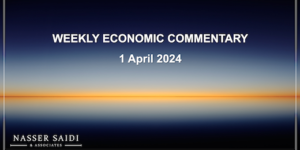Markets
Global markets heading into the summer period are becoming more illiquid and volatile and the worsening macro picture is pushing all indices down. The IPO of AgBank China, touted to be the world’s largest-ever IPO, debuted below expectations in both Shanghai and Hong Kong. In our region, it was a mixed picture – Bahrain and Kuwait gained over the week, while KSA was down in spite of some better-than-expected earnings. Weak US economic data raised recovery concerns leading to dollar weakness, as the euro gained ground and yen hit fresh highs. Oil was flat while gold retreated below $1,200 ounce.
Global Developments
Americas:
- US Senate approved the bill for financial regulation reform. The bill includes new oversight of the over- the-counter derivatives market, a ban on proprietary trading by banks and the creation of a new consumer financial protection bureau to oversee mortgage and credit-card lenders. However, the bill does not address the ‘Too Big To Fail’ issue and does not impose size limitations on banks.
- US trade balance for May widened to a $42.27 bn deficit (Apr: – $40.3 bn). The deficit was a result of 2.4% mom rise in exports to $152.3 bn while imports increased to $194.5 bn from April’s $189 bn
- June retail sales in the US declined -0.5% mom as sales of autos, building materials, and gasoline fell. Excluding autos, the reading was -0.1% mom, a slight improvement over April’s revised -1.2%.
- Jobless claims fell more than expected – by 29k to 429k while continuing claims reversed last week’s sharp drop – rising by 247k to 4.681m, confirming a largely jobless recovery.
- June US industrial production stalled (+0.1% mom, +8.2% yoy) with manufacturing recording the sharpest fall in the year, despite a sharp increase in utility output (+2.7% mom) and a modest gain in mining (+0.4%).
- A dovish outlook from the US Fed raises the prospect of further monetary easing in the US.
Europe:
- June’s harmonized Eurozone CPI was in line with flash estimates – flat mom and down 0.2% yoy (May:1.6%). Core CPI was 0.9% yoy (May:0.8%).
- Eurozone industrial production remained unchanged at 0.9% mom in May.
- Germany’s ZEW indicator dropped 7.5 points in July to 21.2. Respondents were downbeat on Economic Sentiment but were more optimistic about the Current Situation (+14.6 vs. June’s -7.9).
- UK inflation was 0.1% mom in June, (vs 0.2% in May). Core CPI jumped to 3.1% yoy from a previous 2.9%.
- Some positive data boost from the UK: Q1 current account deficit decreased to a £9.62 bn (Q4 2009: £521mln surplus); jobless claims fell by -20.8K in June (May: -31.1K) with unemployment down to 7.8% (Apr: 8.0%).
Asia and Pacific:
- Japan industrial production rose 0.1% qoq in May with capacity utilization at 0.8% mom (Apr: 0.0%).
- Prime Minister Naoto Kan’s party lost control of Japan’s Upper House, undermining efforts to rein in the world’s largest public debt.
- Singapore’s GDP was up 19.3% qoq (26% yoy) in Q2 2010 with manufacturing sector the key driver of growth (+46%) thanks to soaring production in biomedical and electronics.
- Thailand central Bank hiked rates by 25ps to 1.5%.
- India’s industrial production grew 11.5% yoy in May, significantly down compared to April’s 16.5%, as both consumer and capital goods production declined.
- China’s economic growth eased to 10.3% yoy in Q2 2010 and industrial production slowed to 13.7% yoy in June (May: 16.5%). June inflation fell to 2.9% yoy, as food inflation dropped to 5.7% (May: 6.1%).
Bottom line:
Few market moving data were reported last week, but they confirmed the general tendency emerged in the past two months: the Euro area is stalling with fiscal austerity measures and the US recovery is weakening. In China monetary tightening and the yuan revaluation will dampen growth, as was already evident in Q2. In a nutshell, the second half of 2010 will see a gradual glide towards lower global growth rates.
Regional Developments
- Oman’s CPI rose by 2.2% yoy (1.8% yoy) in Q1 2010, as a result of produce prices whose wholesale price rose 9.4% (+18.8% hike in the prices of fruits and live animals by 14.8%).
- Saudi Arabia’s inflation surged to a 13-month high of 5.5% in June (May: 5.4%) as housing and food costs increased substantially.
UAE Focus
- Dubai’s working-age population grew 7.2% yoy in 2009 to 1,570,923 according to a recent report released by the Dubai Statistics Centre. While more than 80% of Dubai’s working-age population was male, Emiratis comprised just 6.8% and had a high unemployment rate of 8.7%.
- At the latest meeting of Nakheel and its creditors, the company confirmed the proposal of a new repayment plan of between five and eight years, carrying an interest rate of 1-2% a year.
- The UAE government has raised the price of fuel by 20 fils, in an effort towards a “liberalisation of prices” – that comes just three months after a rise of 15 fils a litre. The two increases – which total as much as 27%, depending on the grade of petrol – are the first since 2005.





